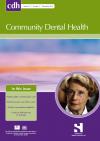Community Dental Health

- Cover Date:
- December 2015
- Vol:
- 32
- Issue:
- 4
Is the value of oral health related to culture and environment, or function and aesthetics?
Objective: To examine the disutility of tooth loss. It compared how people value their teeth in two countries which are culturally similar
in order to explore the effect of culture on self-perceptions of oral health. Basic research design: Cross sectional study. Participants:
Participants were recruited from subjects attending two hospitals in Turkey and in Iran. Interventions: Nineteen descriptions of mouths
with varying degrees and types of tooth loss were presented to the participants. They were shown mouth models of partially edentate
dentitions and the teeth missing were explained in relation to the participants own mouth. The participants were specifically asked to
consider the role their teeth played in function (chewing), communication (speech) and aesthetics (looks) along with “all the other things
that make your mouth important†Main outcome measures: The participants were asked to indicate on a visual analogue scale how they
would value the health of their mouth if they lost the tooth/teeth described and the resultant space was left unrestored. Results: Overall 152
subjects participated, 78 in Turkey and 74 in Iran with 83 being female and 69 male. Their mean age was 29.5 years (SD 9.3), 62.5% had
experienced tooth loss and 37.5% had complete (or completely restored) dentitions. Although there were no differences between the two
countries in the degree of utility people attached to anterior teeth, Turkish participants attached significantly more disutility than Iranians
to the loss of premolar and molar teeth (p<0.003). Conclusion: Country of origin had an influence on the value placed on certain parts
of the dentition and this effect is independent of the number of missing teeth, gender and age. This implies that attitudes to oral health
are influenced by prevalent cultural attitudes more than by function.
Key words: teeth, tooth loss, culture, oral health, utility, Turkey, Iran.
- Article Price
- £15.00
- Institution Article Price
- £
- Page Start
- 204
- Page End
- 208
- Authors
- M.Z. Nassani, E.J. Kay, T.I. Al-Nahha, R. OkÅŸayan, A. Usumez, T.M. Mohammadi
Articles from this issue
- Title
- Pg. Start
- Pg. End
- The feasibility of using an alcohol screening tool in a UK dental setting to identify patients’ alcohol consumption
- 196
- 198
- Long term evaluation of the clinical effectiveness of community milk fluoridation in Bulgaria
- 199
- 203
- Time trends and determinants of acute odontogenic maxillofacial infections in Lithuania: a retrospective national 2009-2013 treatment data audit
- 209
- 215
- Dental anxiety and oral health in 15-year-olds: a repeated cross-sectional study over 30 years
- 221
- 225
- Development and evaluation of a Dental Patient Feedback on Consultation skills (DPFC) measure to enhance communication
- 226
- 230
- A retrospective audit of population service access trends for cleft lip and cleft palate patients
- 237
- 240
- Caregiver financial distress, depressive symptoms and limited social capital as barriers to children’s dental care in a midwestern county in the United States
- 252
- 256
